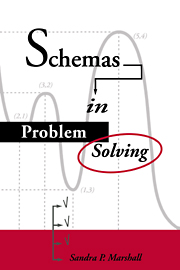Book contents
- Frontmatter
- Contents
- Preface
- Acknowledgments
- I Fundamentals
- II Schemas and instruction
- 4 Theoretical issues for instruction
- 5 The Story Problem Solver and The Problem Solving Environment: Two examples of schema-based instruction
- III Learning from instruction
- IV Schemas and assessment
- V Schema models
- Notes
- References
- Name index
- Subject index
4 - Theoretical issues for instruction
Published online by Cambridge University Press: 22 October 2009
- Frontmatter
- Contents
- Preface
- Acknowledgments
- I Fundamentals
- II Schemas and instruction
- 4 Theoretical issues for instruction
- 5 The Story Problem Solver and The Problem Solving Environment: Two examples of schema-based instruction
- III Learning from instruction
- IV Schemas and assessment
- V Schema models
- Notes
- References
- Name index
- Subject index
Summary
Two characteristics of the schema have far-reaching effects on instruction. One is the componential nature of knowledge associated with it, and the other is its network structure. The impact of the four components of schema knowledge is that we may create sequences of instructional material to focus on each of them. The influence of the network structure is that we will tend to make many more explicit connections between topics of instruction than we might otherwise. Schema-based instruction looks very different from instruction based on other principles.
A point to be highlighted is that students will develop schemas about the subject matter whether instruction takes a schema-based approach or not. Learners will search for structure and relationships. Thus, the questions to be asked about schema-based instruction do not center on whether or not students create schemas. They do. The questions focus instead on the nature of the schemas that are developed. We ask whether the instruction itself can promote more cohesive and better structured schemas than would instruction having another foundation. It is here that the basis set of schemas becomes important, because these lay the groundwork for the instructional design.
A key aspect of schema theory, insofar as instruction is concerned, is that schemas organize knowledge stored in memory. Thus, they provide the necessary scaffolding for a domain, and, as such, they will serve as supports for future instruction and learning. It is useful to consider a simplified overview of instruction to see how this works.
- Type
- Chapter
- Information
- Schemas in Problem Solving , pp. 113 - 127Publisher: Cambridge University PressPrint publication year: 1995



